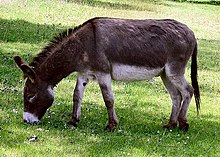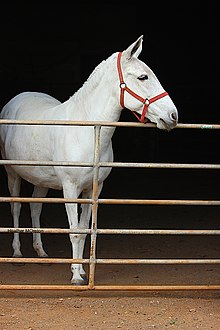A mule is the offspring of a male donkey (called a jack) and a female horse (called a mare). Mules inherit desirable qualities from both donkeys and horses; from the horse they inherit strength and stamina, and like donkeys, mules are generally patient, sure-footed, intelligent and have an even temper. Mules are sterile but female mules are known to produce milk.
Comparison chart
Physical Characteristics
Donkeys have long ears, a short thick head, a short mane, thin limbs and narrow hooves. Mules share these characteristics with donkeys but they are larger and taller than donkeys. The physical characteristics that mules share with horses include shape of the body, a uniform of coat, and teeth. The hooves of a mule are harder than those of a horse.
There is a large variation in the color and size for both donkeys and mules worldwide.
Donkey and "burro" are interchangeable; burro is Spanish for donkey.
Coat
The coat of a mule is usually brown (sorrel) or bay but there is considerable variety just like horses. Other common colors are black and grey, while less common coats are white, roans (both blue and red), palomino, dun, and buckskin.
Donkey are usually grey but some are dark brown, black or light-faced roan. They also have dorsal stripes (a dark stripe from mane to tail) and a crosswise stripe on the shoulders.
Ears
Donkeys have very long ears that are dark at the base and tip. Mules have longer ears than horses but usually somewhat smaller than donkey. The shape of a mule's ears is the same as its parent horse.
Sound
Every mule has a unique bray that is a combination of the horse's whinny and the grunting of the wind-down of a bray. Most mules start out Whinee..... like a horse and end in -aw ah aw like a donkey.
Intelligence
Donkeys are very intelligent and mules share this trait. Horses do not have very high intelligence.
Fertility
Mules are sterile while donkeys can reproduce normally. Donkeys have 62 chromosomes and horses have 64 (or 32 pairs). Mules are hybrids and only have 63 chromosomes, so they cannot produce the haploid cells required for reproduction. The male mule can mate, but the emission is not fertile. Male mules (called johns or jacks) are usually castrated to help control their behavior by eliminating their interest in females. There are no known cases of male mules producing offspring.
Female mules may or may not go through estrus. In general female mules are also sterile but have been known to produce viable offspring in very rare cases.
Diet
Both donkeys and mules love broad-leaved weeds and roughage such as barley straw. This should form a large part of their diet but donkeys must not be fed large amounts of protein, bread, puffed rice or processed food because they may develop foot disease and become lame.
Population of Donkeys and Mules
According to FAO statistics, there are about 12 million mules in the world, with the largest numbers found in China and Mexico (over 3 million each), followed by Brazil (over 1 million). There are about 19 million donkeys worldwide, with over 3 million in China, over 2 million in Pakistan and over 1.5 million in Mexico, Egypt and Ethiopia.
Life span
Donkeys have a life span of 30-50 years. Mules have a lower life span of about 30 to 40 years. In poorer countries, working donkeys have a much lower life span, typically 15 years.






 Frog
Frog  Crocodile
Crocodile  Rabbit
Rabbit  Lion
Lion  Turtle
Turtle  Whales
Whales
Comments: Donkey vs Mule